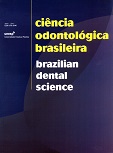Impact of excess cement removal on vertical misfit and cement line quality in onlays
DOI:
https://doi.org/10.14295/bds.2012.v15i3.822Abstract
Aim: To evaluate the vertical misfit and cement line quality of partial ceramic restorations cemented with resin luting cements using two different methods for cement remove excess. Materials & Methods: Lithium di-silicate restorations were fabricated and cemented at 24 human molars that receive onlay type preparations. The specimens were randomly divided in two groups (n=12): Group 1 (G1) where the cement excess was removed at pre-gel stage and Group 2 (G2) with the cement excess removed after the polymerization. The vertical misfits at cement line were measurements twice, before and after cementation. Epoxy resin replicas of the specimens were obtained and the cement line quality was analyzed with the scanning electron microscope before and after the finishing and polishing procedures and classified as unsatisfactory, acceptable or good conditions. The vertical misfits values were submitted to Student test (p<0.05) and the quality line data were analyzed with Mann-Whitney for independent samples (p<0.05) and Wilcoxon test for paired specimens (p<0.05).Results: The statistical analysis showed that vertical misfit and the cement line quality presented no difference values to G1 and G2. However, finishing and polishing procedures affect positively the cement line quality in the both groups. Conclusion: The excess cement removal methods had no influence on the vertical misfit and cement line quality for the restorations. The finishing and polishing procedures improved the cement line quality in both groups.Downloads
Downloads
Published
How to Cite
Issue
Section
License
Brazilian Dental Science uses the Creative Commons (CC-BY 4.0) license, thus preserving the integrity of articles in an open access environment. The journal allows the author to retain publishing rights without restrictions.
=================




























